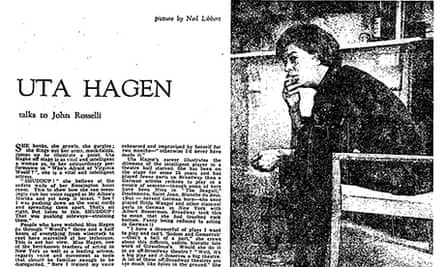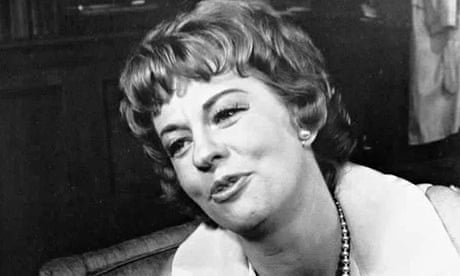She honks, she growls, she gurgles; she flings out her arms, mock-faints, jumps up to illustrate a point. Uta Hagen off stage is as vital and intelligent a woman as, in her extraordinary performance in "Who's Afraid of Virginia Woolf?", she is a vital and intelligent actress.
"SHUDDUP!" she bellows at the sedate walls of her Kensington hotel room. This to show how she can seemingly run her voice ragged as Mr Albee's Martha and yet keep it intact. "See? I was pushing down on the vocal cords and spreading them apart. That's all right. But listen to this. SHUDDUP! That was pushing sideways - straining them."
People who have watched Miss Hagen go through "Woolf's" three and a half hours of everything from wisecrack to rant have marvelled at her technique. This is not her view. Miss Hagen, one of the best-known teachers of acting in New York as well as a leading actress, regards voice and movement as tools that should be familiar enough to be disregarded. "Sure I trained my voice with singing lessons and I tell my pupils to do it too, just as I tell them to learn modern dance. But I don't teach 'stage speech and movement' myself - I don't believe in them. To me they're prerequisites and 'technique' is the actual job of acting - of interpretation, of digging out the interpretation that's lying within the part."
She is a Method actress - but winces at the thought of all the half-baked New York discussions that have clustered about the Method in recent years. Coax her and she will admit to using some of Stanislavsky's own methods without thinking him a fixed star. In rehearsal she improvises - "not scenes from the play itself, that just leads to paraphrase, but scenes from the character's past. If you're working with actors you know very well and who work the same way you can do it very quickly - in three minutes - but what can you do in New York where the company comes together at the blocking-out rehearsal for the first time?" On "Woolf" she first rehearsed and improvised by herself for two months - "otherwise I'd never have made it."
Uta Hagen's career illustrates the dilemma of the intelligent player in a theatre half starved. She has been on the stage for some 25 years and has played fewer parts on Broadway than a German actress reckons to play in a couple of seasons - though some of hers have been Nina in "The Seagull," Desdemona, Saint Joan, Blanche du Bois. (But - herself German born - she once played Hilda Wangel and other classical parts in German in New York with Albert Basserman. Broadway took this to mean that she had touched rock bottom. Fancy being reduced to acting in German!)
"I have a drawerful of plays I want to play and can't. 'Sodom and Gomorrah' - that's a ball of a part," she crows about this difficult, subtle, hieratic late work of Giraudoux's. Would she do it in an off-Broadway theatre? "Well, it's a big play and it deserves a big theatre. A lot of those off-Broadway theatres are too much like holes in the ground." She also wants to do Montherlant's "Port-Royal" - but who is going to finance a play about Jansenism with a cast of sixty?
To continue reading click on the article below.


Comments (…)
Sign in or create your Guardian account to join the discussion